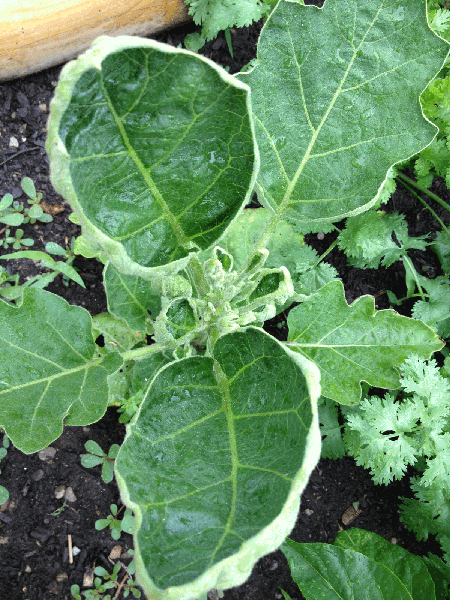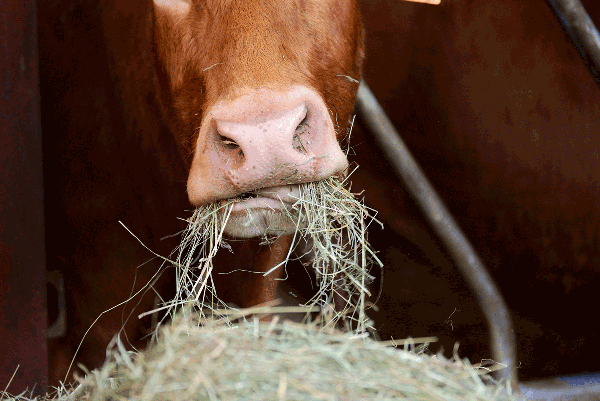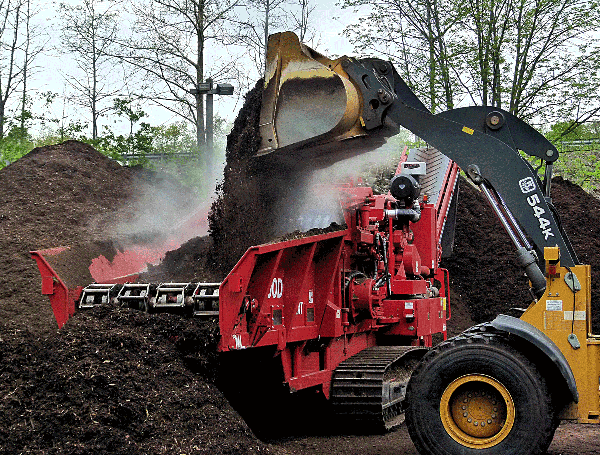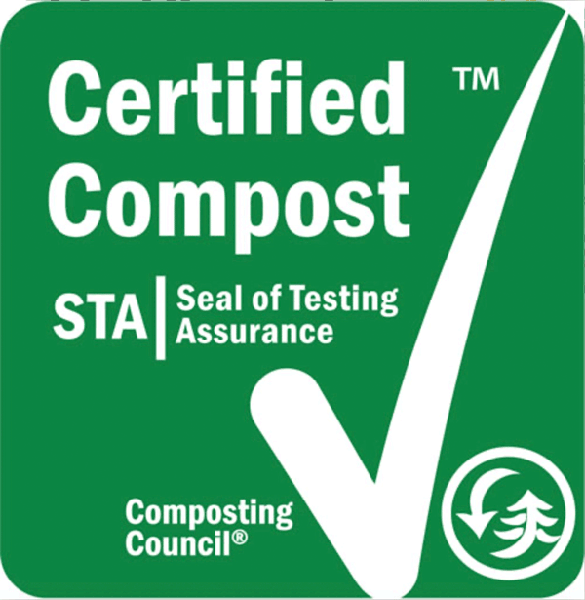Persistent broadleaf herbicides are a group of chemicals used to kill weeds. The group includes both pre-emergent herbicides, applied to the soil to interrupt the germination process, and selective post-emergent herbicides applied directly to the plant to kill broadleaf weeds and not grass. Though they do not kill grass, they can be taken up by grass, consumed by horses or cows, passed through the digestive tract, expelled as manure, and still remain active after composting. Plant injury caused by herbicide residues in compost or manure can be similar to injury caused by herbicide drift or volatility (evaporation) from these same and other auxin-like herbicides.
During thermophilic composting, high temperatures and microbes destroy most herbicides. However, persistent herbicides (such as the ones described in this publication) may remain viable for many months.
Answers to Frequently Asked Questions
Learn to prevent contamination, identify symptoms, and manage compost and soil contaminated with persistent broadleaf herbicides by reviewing these answers to frequently asked questions.
What is wrong with my plants?
Have you noticed that your garden plants are not growing normally? Have you experienced poor seed germination or even the death of young plants? Do plants have twisted, cupped, and elongated leaves; misshapen or smaller fruit; and reduced yields? (Figure 1 and Figure 2) These symptoms, shown in NC State Extension publication AG-727, Herbicide Carryover in Hay, Manure, Compost, and Grass Clippings, are similar in appearance and could be caused by plant diseases, nutrient deficiencies, or insect pests. However, it may also be that manure or compost applied to your garden soil is contaminated with persistent broadleaf herbicides.
What are persistent broadleaf herbicides and where are they used?
Herbicides are a type of pesticide intended to kill weeds. Broadleaf herbicides are commonly used to kill broadleaf weeds that grow among grass crops such as turf, corn, wheat, barley, pasture grasses, or hay. Grassy crops are not affected by broad-leaf herbicides because of their hormone and metabolic systems. Broad leaves have a flat, broad surface with a network of prominent veins. Unfortunately, broadleaf plants do not just include weeds, but also most flowering plants as well as fruit and vegetable crops that are grown for food.
Some herbicides are called persistent because they can last for a long time in the environment. When these types of herbicides stay in the soil, they can damage garden plants over multiple years.
In persistent broadleaf herbicides the active ingredients (the ones that kill plants) are clopyralid, aminopyralid, aminocyclopyrachlor, and picloram (EPA, 2021). The use of clopyralid was restricted by the manufacturer in 2002 to non-residential lawns and turf only (office parks, playgrounds, and golf courses), along with rangelands, pastures, roadways, railways, and forests, so these are the only places clopyralid can legally be used.
Which plants or crops are affected?
As would be expected, many broadleaf crops are sensitive to the effects of persistent herbicides. Some crops may be more sensitive than others, but nearly all vegetable crops can be affected by persistent herbicides. The following crops are known to be sensitive to the persistent herbicides picloram, clopyralid, or aminopyralid:
- Herbs: parsley
- Flowers: compositae family (daisies), dahlias, flowers in general, marigolds, roses, sunflowers, and fruits: grapes and strawberries
- Vegetables: beets, carrots, celery, eggplant, legumes, lettuce, peas, peppers, potatoes, spinach, and tomatoes.
- Other: cotton, mushrooms, and tobacco
Some notable exceptions include asparagus, corn, leeks, and onions. These are all related to grasses, which are not targeted by broadleaf herbicides.
What are typical symptoms?
- Poor seed germination
- Death of young plants
- Twisted, cupped, and elongated leaves (Figure 3)
- Misshapen fruit
- Reduced yields
Nutrient deficiencies, plant diseases, and insects can cause similar symptoms to persistent herbicide damage. However, if multiple types of broadleaf plants are affected, grass-like plants are not affected, and only one part of the plant is affected, it may be herbicide damage. If neither you, nor anyone near your plants have applied herbicides, the damage may be from persistent broadleaf herbicides in compost.
How did the herbicides get in my yard?
Persistent broadleaf herbicides may have been used to manage broadleaf weeds in pastureland. Herbicide residues may exist in forage crops, pasture grasses, or hay that livestock eat for food (Figure 4). These residues are not broken down when digested by livestock, and they are found in manure in addition to forage crops themselves. If either the forage crop or the manure is used for compost, persistent herbicide residues may remain intact and can still be active even after the composting process is complete, leading to unintended damage (Daughtery and Kerley, 2018).
Herbicide-contaminated compost is an ongoing problem in North Carolina and across the country. Some garden plants can easily take up herbicides from the soil, which then disrupt normal plant growth (Davis et al., 2018). Tiny amounts of these herbicides (even as little as 3 parts per billion) can impact some garden plants. Several of these herbicides can persist in compost and soil for several years (Michel et al., 2015).
NC Policy Watch documented a specific case of contamination by the broadleaf herbicide, clopyralid, in compost sold in North Carolina during the 2020 growing season (Sorg, 2021). The article describes the possible sources and widespread impact of the contaminated compost on home gardeners, small farmers, and composters. The article further describes the response from the U.S. Composting Council (USCC), the public comment process on the issue from the U.S. Environmental Protection Agency (U.S. EPA), and recommendations from NC State Extension for amending soil.
Why is it difficult to prevent contamination of compost?
Commercial pesticide users are required to comply with the directions for use on pesticide labels. Each state is responsible for enforcing those requirements and assessing any fines or other enforcement actions, located at section 14(b) of the Environmental Protection Agency’s Federal Insecticide, Fungicide and Rodenticide Act. Farmers and landscapers who use persistent broadleaf herbicides are instructed by the pesticide manufacturer not to use hay or straw treated with the herbicide for compost or other application in vegetable gardens, nor manure generated from livestock that have fed on that hay or straw (Corteva Agriscience, 2019). These users must also notify landowners not to use treated grass clippings for compost.
However, large-scale compost creation can be complex, and typically includes a variety of raw materials (feedstock) from many different sources (Figure 5). In addition, compost feedstock materials can pass through many hands before being incorporated into finished compost (Davis et al., 2018). For this reason, and because the herbicides cause adverse effects at very low concentrations, it can be difficult to trace the source(s) of contaminated feed stock(s) for any given batch of compost. Also, the process for testing compost for herbicide contamination with bioassays is relatively slow, too slow for commercial facilities to test each batch before shipment. Furthermore, laboratory analysis of chemical residues can be prohibitively expensive.
Is this a human health concern?
It is unlikely that plants exposed to these herbicides will mature to edible fruits and vegetables. If they do, discard the produce unless you can identify the exact herbicide and the concentration within the produce. There are labs that can test for residue in the harvested product, for example, the Waters Agricultural Lab. Once you know the exact herbicide, call the National Pesticide Information Center at 1-800-858-7378 to learn about potential risks.
U.S. EPA concluded that clopyralid has no human health risks other than the potential to become a severe eye irritant when diluted in water for pesticide application (U.S. EPA, 2020). Picloram has been found to be only slightly toxic by the oral and dermal routes (U.S. EPA ,1995) and there are no human health risks of concern for any registered uses of aminopyralid (U.S. EPA, 2021) or aminocyclopyrachlor (U.S. EPA, 2016). The concentrations of these herbicides in compost (in the parts per billion range) is significantly lower than the U.S. EPA-allowed residues for each of them in food crops, which are in the parts per million range (0.4-50 ppm) (U.S. EPA, 2017). See Food Safety in Community and School Gardens for more information.
Who regulates compost?
USCC has a voluntary program under their Seal of Testing Assurance (STA) Certified Compost program. All STA Certified Compost manufacturers must meet U.S. EPA standard limits for pathogens and metals in every test to remain in the program (Figure 6).
Some STA certified composters can also choose to produce compost with a higher standard of test results, called the Compost Consumer Use Program. Compost produced under this program is classified for its intended use into three categories: trees and shrubs, flowers and vegetables, and lawns. Compost for use in flowers and vegetables must conform to a series of restrictions for moisture content, organic matter, pH, particle size, and salt content, in addition to restrictions placed by federal and state governments limiting the amount of metals and biological contaminants. However, none of these standards involve testing for herbicide residues.
Composters and the USCC are aware of the problem. The USCC has produced fact sheets for their member organizations and created a compost process certification to help reduce contamination. The Composting Council also asks that gardeners report if they have been affected by contaminated compost, and have set up a form to collect this information.
Taking Action
Avoid purchasing compost that contains persistent herbicides
Making your own compost gives you control over the ingredients (Sherman, 2017). If you decide to purchase compost, contact the supplier and learn what feedstocks they use. Some potential red flags for herbicide contamination are straw or hay, lawn clippings, or animal manure. If they are unsure of the feedstock or list a potentially contaminated source, consider purchasing elsewhere.
Test compost before adding to your garden soil!
Persistent herbicides can damage plants even at levels lower than a lab may be able to detect. If you’re not sure whether your compost is free of herbicides, you may want to run a simple, inexpensive bioassay before applying the compost to your garden or landscape. Bioassays are sensitive, affordable tests you can do in pots or within your garden if you’ve already added compost. When planning to run a bioassay, keep in mind that it will take three to four weeks to complete.
Bioassay steps (adapted from (Davis et al., 2020)
- Take several small shovelfuls from throughout the pile of aged manure or compost, and be sure to get deep inside the pile. Mix thoroughly. [Note: dry pockets of compost will likely contain higher concentrations of herbicide residues than moist sections. Test dry pockets and moist sections separately.] (Figure 7)
- Prepare three to six small (4- to 5-inch) pots. Fill some with a 1:1 mix of the compost and a commercial potting mix that contains fertilizer. Fill at least one pot with only the commercial potting mix, no compost or manure. (Figure 8)
- Label all pots to know which ones have the compost/manure.
- Put saucers underneath each pot, or position the pots far enough apart ensuring that water running out of the bottom will not reach any of the other pots.
- Plant three pea or bean seeds in each pot, water normally, and let them grow for two to three weeks.
- There should be at least three sets of true leaves on the peas or beans at that time. Monitor the pots for normal /abnormal growth including poor seed germination, twisted, cupped, and elongated leaves, and death of young plants.
If the plants grown with the compost exhibit problems like those described above, and plants grown without compost look healthy, then you can assume that the compost is contaminated.
You can also have the compost tested by a private lab. The following are sources for certified soils professional consulting, sampling, and analyses (inclusion here does not imply endorsement of any specific service or suggest that alternatives not mentioned are unsuitable). However, be aware that chemical residue testing is more complex than typical soil fertility testing. Testing for herbicide residues can be relatively expensive, and you will need to specify exactly which chemical analyses you wish conducted.
- Active Licensed Soil Scientists in North Carolina, with designation of the area of the state providing consultation.
Options if compost is contaminated with persistent broadleaf herbicides
Contaminated compost can be spread on turfgrass which is not harmed by broadleaf herbicides. However, if you have already incorporated the contaminated compost into your garden soils, below are some options for remediation. Remember, these herbicides can remain active in the environment for a year or even longer. (Davis et al., 2020; US Composting Council, 2021).
Report the incident to the seller, your state’s pesticide regulatory office and to the USCC.
Seek assistance from your local N.C. Cooperative Extension Agent.
Lower Cost Remediation Options
- Use plants to remove the herbicide from the soil. Phytoremediation involves growing plants known to take up the herbicide and then at the end of the season disposing of the entire plant (roots, stems, and leaves) and the herbicide the plant has absorbed, where it will not cause further soil contamination. Do not put the plant in your compost or in the greenwaste pick up. Barley, corn, sudan grass, and wheat, or any non-sensitive plant with high summer biomass production can bioaccumulate the herbicide.
- Grow plants resistant to the herbicide: Grow only monocotyledons (for example, corn, grass, and onions) until the herbicide breaks down. Conduct bioassays each year using peas, beans and/or tomato seeds or plants to evaluate the impact of the remaining herbicide. When these sensitive species grow normally, it will be safe to plant your garden. Residues usually dissipate within a year but may remain longer if the soil is dry.
- Relocate the garden to an alternate site that has not received the contaminated compost.
Medium Cost Remediation Options
- Install a raised bed over the contaminated soil. Use a rubber (pond liner) or plastic barrier between the contaminated soil and the raised bed. Drill holes along the sides of the raised bed near the bottom to allow for drainage. Then fill the bed with new, uncontaminated soil.
- Treat the soil: Add water and compost or organic matter from another clean, safe source to dilute the contamination and cause the herbicide to breakdown. Add activated carbon or wood ash to reduce signs of toxicity. Keep the soil warm and moist to promote chemical breakdown of the herbicides. A study by researchers from the Ohio State University, in cooperation with the USCC, evaluated remediation methods for contaminated soils using bioassays with bean seedlings. The researchers found that activated carbon and, to a lesser extent wood ash, when added (2% dry weight) to soils containing contaminated composts with 30-600 ppb of aminopyralid, reduced signs of phytotoxicity (Michel et al., 2015). Adding 1% activated carbon (dry weight) to large composting operations has been found to remove 100 ppb of persistent herbicides from that compost (Michell, 2015). If you would like to try treating your contaminated soil, try reaching out to your local Extension Agent.
Higher Cost Remediation Options
- Remove and replace the soil: If you want to be 100% sure of removal of the herbicide, you may need to dig out the compost amended soil. To dispose of it, you could spread it on your lawn where it will suppress broadleaf weeds, move it to an area of your yard that does not actively grow plants such as a mulched area, or dispose of the soil (contact your local solid waste office to find the best local option).
Regardless of the type of garden plan you grow, you should NOT compost plant materials grown in soil contaminated with persistent herbicides. You should also not supply any of this plant material to composting municipalities or private companies. Doing so could continue the cycle of compost contamination and impact additional gardens.
Report contaminated compost
- North Carolina Department of Agriculture & Consumer Services Pesticide Section, (919) 733-6100.
- The U.S. Composting Council, Report Form.
- U.S. EPA periodically considers these reports of contamination when reviewing herbicide registrations.
Costs of herbicide-contaminated compost
Herbicide contamination can affect stakeholders throughout the compost supply chain, from farmers to distributors and consumers. Once contamination occurs, it can be difficult and/or costly to remediate, remove, or replace. Home and community gardeners may be forced to take on the costs of replacing compost and soil, and face decreased plant productivity that could potentially last multiple years.
Additional Resources
- Check Your Dirt NC - Tool to identify and address problems related to soil contamination
- Food Safety for School and Community Gardens
- Garden Soil Contaminant Resources and FAQ
- Herbicide-Contaminated Compost and Soil Mix: What You Should Know — and What You Can Do About It
- Herbicide Contaminated Soil and Amendments
- Herbicide injury – Symptoms and Fact Sheets from NC State Extension
- Minimizing Risks of Soil Contaminants in Urban Gardens
- Tainted Compost Affects Growers in North Carolina
References
Daughtry, M. and P. Kerley. 2018. “Herbicide Carryover in Hay, Manure, Compost, and Grass Clippings. Caution to Hay Producers, Livestock Owners, Farmers, and Home Gardeners.” NC State Extension.
Davis, J., S.E. Johnson, and K. Jennings. 2020. Herbicide Carryover in Hay, Manure, Compost, and Grass Clippings. AG-727. NC State Extension.
Michel Jr., FC, K.M. Speicher, B. Zang, and L. Huezo. 2015. “How Widespread are Persistent Herbicides? Results of a Nationwide Survey.” US Composting Council Annual Meeting abstracts. Washington DC: US Composting Council. (Jan 2015) EPA-HQ-OPP-2014-0167-0029
Sherman, R. 2017. Backyard Composting of Yard, Garden and Food Discards. AG-791. NC State Extension.
Sorg, L. 2020. “PW exclusive: Herbicide-tainted compost plaguing NC farmers and gardeners.” NC Policy Watch. (August 2020).
Tharp, C. and A. Bowser. 2016. Minimizing Pesticide Contaminated Soil Around the Home and Garden. Montana State University Extension.
U.S. Composting Council. 2021. Persistent Herbicides FAQ
U.S. Environmental Protection Agency. 2016. Aminocyclopyrachlor; Pesticide Tolerances. 40 CFR Part 180, HQ-OPP-2011-0144; FRL-9944-48.
U.S. Environmental Protection Agency. 2017. Clopyralid; Pesticide Tolerances, EPA–HQ–OPP–2017–0035; FRL–9977–13.
U. S. Environmental Protection Agency. 2014. Code of Federal Regulations. Title 40 - Protection of Environment, Volume: 24, Chapter 1, Subchapter E - Pesticide Programs Part 180 - Tolerances and Exemptions for Pesticide Chemical Residue in Food. aminopyralid, clopyralid and picloram
U.S. Environmental Protection Agency. 2020. Memorandum: Authorization to Extend the Public Comment Period for Clopyralid, EPA-HQ-OPP-2014-0167-0096.
U.S. Environmental Protection Agency. 2020. Memorandum: Clopyralid Use, Usage and Benefits. EPA-HQ-OPP-2014-0167-0048
U.S. Environmental Protection Agency. 1995. R.E.D Facts: Picloram EPA-738-F-95-018
U.S. Environmental Protection Agency. 2018. Registration Review Process
U.S. Environmental Protection Agency. 2021. Registration Review of Pyridine and Pyrimidine Herbicides
Acknowledgments
The authors appreciate the helpful reviews provided by Dr. Katie Jennings and Dr. Joe Neal of the NC State Department of Horticultural Science, and Dr. Ellen Bauske at the University of Georgia — Center for Urban Agriculture. We also appreciate the images provided by Dr. Jeanine Davis, Dr. Joe Neal, Cary Oshins, and Sue Colucci.
This work was supported through the National Institute of Environmental Health Sciences P42 Multi-project Center Grant program, grant number P42ES010356.
Publication date: April 20, 2022
AG-920
Recommendations for the use of agricultural chemicals are included in this publication as a convenience to the reader. The use of brand names and any mention or listing of commercial products or services in this publication does not imply endorsement by NC State University or N.C. A&T State University nor discrimination against similar products or services not mentioned. Individuals who use agricultural chemicals are responsible for ensuring that the intended use complies with current regulations and conforms to the product label. Be sure to obtain current information about usage regulations and examine a current product label before applying any chemical. For assistance, contact your local N.C. Cooperative Extension county center.
N.C. Cooperative Extension prohibits discrimination and harassment regardless of age, color, disability, family and marital status, gender identity, national origin, political beliefs, race, religion, sex (including pregnancy), sexual orientation and veteran status.







